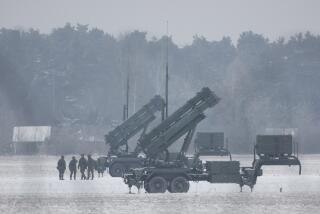Arms Losses in War Could Drain U.S. Defense Budget
- Share via
If the U.S. military sustains even moderate losses of weapons in a Persian Gulf war, the nation will find it financially prohibitive to replace them, given sharp increases in the prices of jet fighters, guided missiles and tanks in recent years.
The price tag could reach $50 billion, based on the current production cost of those weapons, according to government estimates obtained by The Times. That is more than half the Pentagon’s annual procurement budget. And if the military decides to replace the lost weaponry with newer-generation systems under development, the cost could soar even higher.
Next-generation planes such as the advanced tactical fighter (ATF) and the agile Falcon aircraft would cost 250% more than the existing front-line fighters that would be lost in the gulf, one government budget analyst has stated in a report.
At a minimum, as Defense Secretary Dick Cheney has acknowledged, a war would wipe out any hope of harvesting a “peace dividend” from the end of the Cold War in Europe. And as war losses mounted, the nation would face a difficult choice: either to further enlarge the already worrisome budget deficit or put domestic spending under ever tighter restraints.
Some experts are hopeful that the losses incurred in a Middle East war would simply hasten the retirement of weapons planned as part of a reduction of forces after the end of the Cold War.
But battle losses are unlikely to fit neatly into disarmament plans, other experts say. The Pentagon would probably lose its best aircraft, missiles and tanks rather than the older, obsolete weapons that it had planned to retire, they warn.
“The military policy has always been to deploy our most capable forces at the forward front, so if we go to war it is reasonable to expect our losses will include our most modern equipment,” said Mike McClendon, who stepped down in recent weeks as a principal analyst at the Pentagon.
For example, the Air Force’s oldest fighter aircraft, Vietnam-vintage F-4 Phantoms and A-7 Corsairs, are not even deployed in the Persian Gulf. Any battles would be fought with the newest F-16s and F-15s. Similarly, the Army just moved its newest M-1A2 tanks from Germany to Saudi Arabia and pulled older M-1A1 and M-60 tanks from the front, McClendon said.
If the Pentagon loses many of its best weapons, it could find itself in an unprecedented bind. For the first time, the military either may not replace the equipment it loses or may be precluded financially from replacing it with next-generation weaponry.
“If we lose F-15s, we can’t afford advanced tactical fighters to replace them,” said former Undersecretary of Defense Robert Costello.
The Air Force estimates the cost of each ATF at more than $50 million, not accounting for the $10-billion to $12-billion cost of development or the cost of future inflation. Critics say it is likely to cost far more than that.
Still, the military expects to get its money’s worth. The ATF is designed to be faster, more maneuverable and harder for enemy radar to find than existing F-15s--a prime example of the Pentagon’s strategy over the last three decades of demanding ever-more-sophisticated weapons.
But the trend of price increases for these high-technology systems has pointed inevitably to a day of reckoning, when the price for each tank or aircraft would become so high that only a ridiculously small quantity could be purchased with available funds. That day, many analysts say, now seems very close at hand.
Each B-2 bomber, for example, will cost $840 million--a price some critics say will eventually escalate to $1 billion. As the price increased, the Air Force was forced to cut its order from 132 to 75 of the planes. With so few planes, the service could ill afford to sustain many losses in a battle.
“I don’t think you would ever use the B-2 bomber in a conventional war,” said Costello, who was the Pentagon’s acquisition chief in the Ronald Reagan Administration. “I don’t think any country could afford to put at risk an airplane that costs $1 billion.”
Even though the Pentagon went on a historic spending spree during the 1980s, the growth in weapons prices meant that it could afford smaller quantities of missiles, aircraft and other sophisticated weapons each year. As a result, the average age of such equipment has crept steadily upward since the Vietnam War, said Charles Spinney, a Pentagon weapons analyst.
The average age of the Air Force’s tactical aircraft, for example, grew from 10.1 years in 1973 to 16.2 years in 1989. The age of the typical Navy ship went from 14.7 years in 1974 to 19.6 in 1989--and that was after the huge Navy buildup of the 1980s.
The loss of significant quantities of newer equipment in a gulf war would only exacerbate the age problem.
Although military officials say that no detailed plans have been laid for the replacement of equipment lost in the Persian Gulf, they have turned to computer models and past experience to assess just how many weapons would be destroyed.
The Air Force believes that in the opening phase of a war, it could lose as many as 100 top-of-the-line warplanes. Outside analysts say the number of planes lost could reach 800 in the course of a war. The Army could lose anywhere from 200 to 900 tanks, government budget analysts say.
To replace the lost equipment would cost $50 billion, a recent government report says. As much as $30 billion of that amount would go toward the replacement of major weapons such as aircraft and tanks. The remaining $15 billion to $20 billion would refill stocks of missiles and ammunition.
If the losses were replaced with next-generation weapons, however, the cost of rebuilding U.S. forces in the wake of a war could vastly increase. For aircraft alone, replacing lost warplanes with more futuristic aircraft such as the advanced tactical fighter and the next-model F-16 would increase costs by roughly 250%, one government budget analyst has calculated.
On the ground, buying current-generation M-1A2s instead of older M-1A1s would cost 35% more--roughly $4 million per tank versus $3 million. Budget analysts suggest that waiting for the next generation of tanks will send costs up another 30% to 50%.
But some military experts dispute such scenarios, saying that it is impossible to predict how much equipment will be lost in a Persian Gulf war or even whether the military will face a replacement problem after a war.
“There is obviously an air campaign plan that is waiting to be executed, and unless you have that plan and you know what the threat against it is, then you can’t make an attrition assumption,” said Lawrence Skantze, a retired general who was the Air Force’s procurement chief. “I personally wouldn’t venture a guess.”
Skantze also believes that the losses in a gulf war would not exceed the amount of equipment already due to be retired with the end of the Cold War.
The Air Force has been planning to reduce its tactical forces from about 35 wings, each with 72 aircraft, to 26 wings--a reduction of about 650 aircraft. The Army plans to cut its forces from the current 16 divisions to 12 divisions by 1996. The Navy expects to retire one or two of its 14 aircraft carriers.
“So whatever our losses, they would fall well within whatever the draw-down objective is,” Skantze said. “It would be very intense from an air war standpoint and be over in a few days.”
Nonetheless, Defense Secretary Cheney recently conceded that a Middle East war could very well cost the United States the “peace dividend” that Congress had hoped to reap from the end of the Cold War in Europe.
Cheney said that if war came in the Persian Gulf, the Pentagon would “probably . . . at least in the short term” abandon its plan to scale back spending. Later, the military would apparently go forward with its downsizing--but at no savings, a prospect sure to raise the ire of Congress.
The Defense Department’s longstanding preference for a small arsenal of high-tech weapons rather than a larger arsenal of simple ones has become intolerable and wasteful, said Rep. Andy Ireland (R-Fla.).
“You get a much smaller, high-tech military at a higher price. And you get a post-Cold War era arsenal that would require a Cold War budget to keep it running,” Ireland said. Not only are high-tech weapons more costly to buy initially, but they are more expensive to operate for years to come, he said.
A recent study by the Congressional Research Service found that the Persian Gulf deployment already is costing only slightly less than the massive combat operations at the height of the Vietnam War.
Ireland blames the costs on advanced weapons that are more difficult to maintain and operate than Vietnam-era equipment.
“Every modernization effort is sold to Congress and to the public on the basis that it will reduce operating costs down the road,” Ireland said. “This report shows just how ridiculous that is.”
Future defense budgets simply will not accommodate the across-the-board equipment modernization that the Pentagon has proposed--and that a Persian Gulf war would theoretically accelerate, said Lawrence Korb, a former assistant secretary of defense during the Reagan Administration.
“You never could proceed with all those modernization programs,” Korb said. “Even at the height of the Reagan Administration build-up, you had way too many.”
Vartabedian reported from Los Angeles and Healy from Washington.
LITTLE PLANNING: Few companies have made war contingency plans. D1
GULF SHIPPING: A gulf war seems unlikely to produce disruptions in world shipping. D1
EXCHANGES READY: Stock and commodities exchanges are prepared to cope with volatile trading. D4
More to Read
Sign up for Essential California
The most important California stories and recommendations in your inbox every morning.
You may occasionally receive promotional content from the Los Angeles Times.















